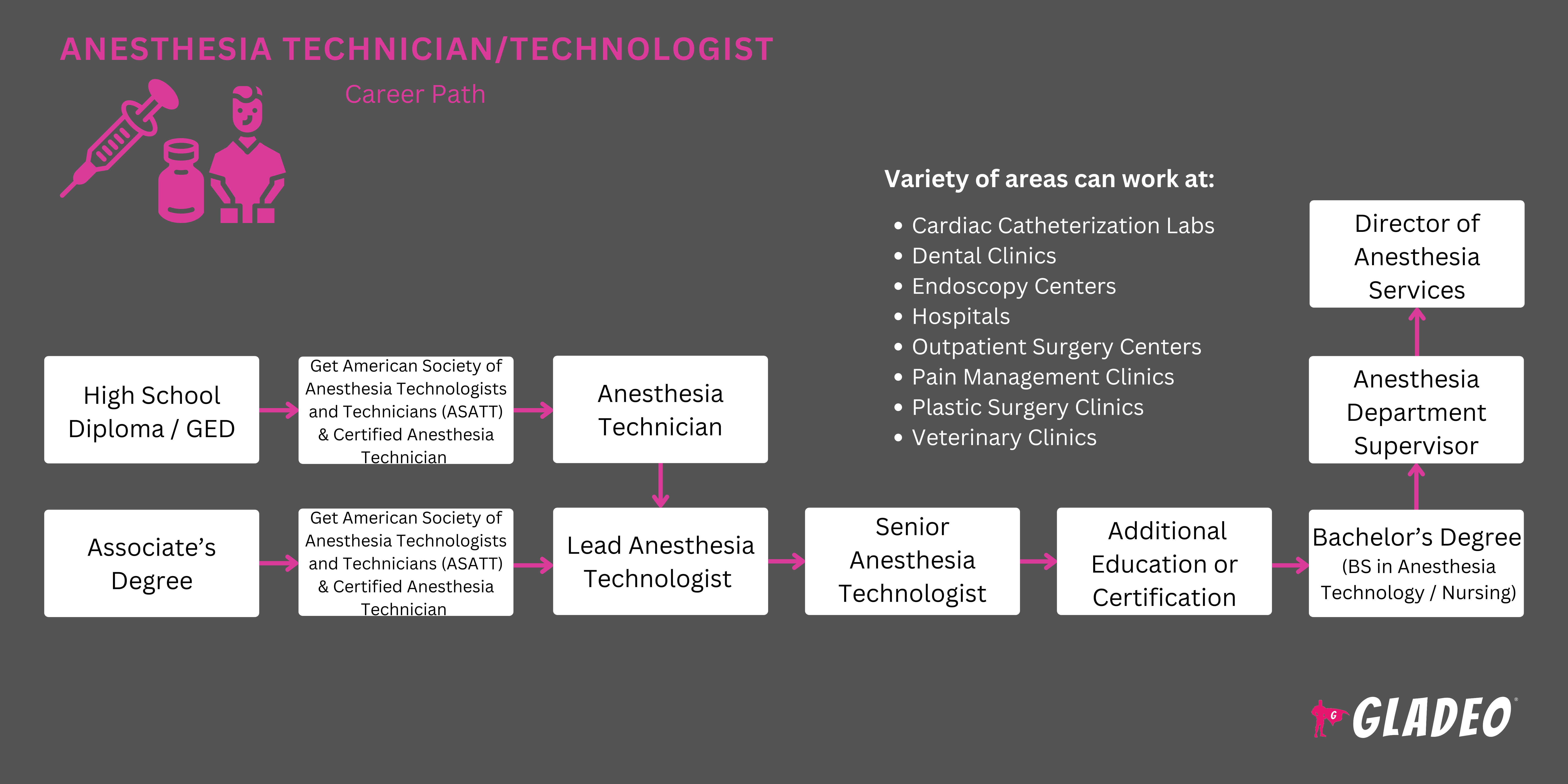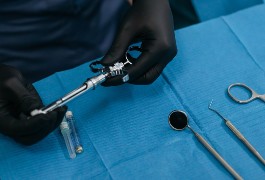Spotlights
Anesthesia Technologist, Anesthesia Assistant, Anesthesiologist’s Assistant, Certified Anesthesia Technician, Certified Anesthesia Technologist
Surgery and other medical procedures often require the use of anesthesia to ensure that a patient is as comfortable as possible during their visit. Anesthesia varies, but can include full sedation, where the patient is completely ‘asleep’, to pain blocking measures that do not impact the patient’s consciousness. Anesthesia Technicians and Technologists support Anesthesiologists and Nurse Anesthetists as they supply care and check patients through their anesthesia experience.
This support is given in many ways, including helping the Anesthesiologist get ready for medical procedures by cleaning tools and equipment and preparing medications for the Anesthesiologist to administer. Monitoring a patient's vital signs during and after procedures is another responsibility the AT takes on, along with aiding the patient through recovery. Although surgery is what most people think of when they hear anesthesia, an AT can work in many locations within the medical field. Surgical operating rooms, ICUs (Intensive Care Units), Emergency Rooms, Labor and Delivery wards, outpatient clinics and more are all common working locations.
- Help provide care for individuals during stressful times in their lives
- Opportunities to learn, grow, and specialize
- Job stability in the medical field remains high
- Good pathways to continuing education and certifications
Anesthesia Technicians/Technologists work inside various medical facilities and under the supervision of other medical professionals such as Anesthesiologists, Physicians, and Nurse Anesthetists. Non-certified Anesthesia Technicians provide general support to an Anesthetic Care Team (ACT) by assisting with supplies, whereas a Certified Anesthesia Technician/Technologist will have more training and education and will work more closely with patients and provide higher-level aid to the ACT.
Most Anesthesia Technician/Technologist jobs will offer full-time positions, and the opportunity to travel to different facilities to work if they choose. Although you do not have to have a certification to become an Anesthesia Technician, most employers prefer that you have some medical education or experience.
Typical Duties
- Acquire and inventory supplies for use by the ACT
- Perform cleaning and sterilization of medical supplies and equipment
- Obtain patient health history prior to anesthesia
- Aid in calculating dosage and preparation of anesthetic drugs
- Monitor patient vital signs such as blood pressure, oxygen level, and heart rate before, during, and after anesthesia
- Help supply oxygen, nitrous and other medically necessary inhalants to patients
- Cross schedule procedures with other medical departments
- Gain familiarity with a variety of surgical and medical procedures
- Act as a liason between the rest of the ACT and the patients/patient’s family
- Monitor surgical room for safety by checking for any medical inhalant leaks
Additional Responsibilities
- Perform maintenance/verify servicing on medical equipment.
- Monitor patient’s airway, aid in intubation/ventilation.
- Manage IV fluids, blood, plasma, and other fluids.
- Aid in life-sustaining care, including CPR if necessary.
Soft Skills
- Problem-solving – must be able to quickly overcome difficulties.
- Verbal communication – to relay information to patients and other members of the ACT.
- Active listening – paying close attention to the information given by patients and other members of the ACT.
- Reading comprehension.
- Written communication.
- Science – must have a basic grasp of scientific rules and methods.
- Service-oriented – able to put the needs of others first and show consideration.
- Time management.
- Judgment and decision making – can make decisions based on knowledge and skills, even in a time-sensitive or strenuous situation.
- Operations monitoring – to monitor equipment used during anesthesia.
Technical Skills
- Microsoft Office Suite
- Microsoft Excel
- Microsoft Word
- Understanding of the use and monitoring of medical equipment like ventilators and electrocardiograms.
- Various medical software such as:
- Allscripts PM
- Bizmatics PrognoCIS EMR
- CareCloud Central
- eClinicalWorks EHR software
- Epic Practice Management
- GalacTek ECLIPSE
- GE Healthcare Centricity Practice Solution
- IOS Health Systems Medios EHR
- McKesson Practice Plus
- simplifyMD
- Vitera Healthcare Solutions Vitera Intergy
- WRSHealth EMR
Although surgical settings are where you would expect an Anesthesia Tech to work, their job settings can vary greatly and include:
- Dental Offices
- Imaging centers for MRIs, CT scans, etc.
- Labor and Delivery wards
- Emergency Rooms
- Outpatient clinics
- ICU (Intensive Care Unit)
- NICU (Neonatal Intensive Care Unit)
Anesthesia Techs generally work full-time shifts and may be required to work long hours and varying shifts. Depending on the medical practice that you are employed with, this could include night shifts and be on call, even on weekends and holidays. A lot of time will be spent on your feet, with moderate physical exertion like moving patients and heavy equipment.
The job can also be emotionally taxing and taking care of others who are often experiencing extreme pain or illness can cause internal stress. There is also the possibility of being exposed to communicable diseases, bodily fluids, and poor medical outcomes. You are required to maintain professionalism and attitudes proper to the situations you are in.
Although many children go through phases where they pretend to ‘play doctor’, others will show more nuanced interests and behaviors. These can include watching television shows that include the medical field, or a strong interest in the human body and science. As a kid, if you wanted to be able to help people and weren’t bothered by ‘gross’ things like blood, you may have shown a very early interest in the field.
- High School Diploma or Equivalent is required.
- Certification Program through a school recognized by The Committee on Accreditation for Anesthesia Technology Education (CoA-ATE). These programs can take 1-4 years to complete.
- You should have an Associate’s Degree by the end of the Certification Program
- Certification Testing through The American Society of Anesthesia Technologists and Technicians ASATT after the Certification Program and Associate’s Degree are completed
- Recertification every two years
- In order to recertify, 30 continuing education hours are required in that recertification window. These can include attending lectures and serving on relevant boards. This process is in place to ensure that Anesthesia Techs remain current on new information in their profession.
- Any state-level requirements
The most important thing to look for if you are trying to become a Certified Anesthesia Technologist is to find a CAAHEP accredited / CoA-ATE approved program. This is the most direct route to entering the field with the correct education.
- Maintain a high GPA. There are not a lot of schools that offer the certification, and they may be selective about their candidates.
- Pursue continuing education through early college credits in the medical field.
- Obtain CPR certification.
- Volunteer in hospitals.
- Get a head start by viewing information from conferences and lectures hosted by ASATT.
- Decide if you want to specialize in any area and begin work pursuing additional education information in that field.
- Look into whether your state offers the chance to work towards your Associate’s Degree while still in high school.
- Explore Preparatory Classes

- Present yourself as a professional: This job requires an elevated level of emotional maturity and the ability to communicate and set others at ease. Project that attitude during the hiring process.
- Find the location you would prefer to work in and look for all possible openings where an anesthesiologist performs work.
- Have all of your certification information neatly available for review and verification.
- If you have the time available, volunteer at facilities prior to your certification so that you’re already familiar with the facility and the administration.
- Prepare for your interview by checking out industry-specific tips on acing your interview.
- Polish your resume and check that you have included relevant data. It is a good idea to learn how to highlight your achievements in school if you are entering the workforce right out of college.
- Check with your school’s resource center to see if you qualify for any job placement assistance.
- Find employment resources within professional organizations, such as the certifying body.
- Put your best foot forward in choosing the right interview attire.
- Provide outstanding care to your patients. They are your number one priority during work, and that dedication will ensure positive patient post-care reviews.
- Punctuality is key; an entire surgical team could be held up if you are not present when you should be. That is a costly and possibly life-threatening mistake.
- Stay on top of your continuing education and look to add other relevant certifications as needed.
- Attend conferences and lectures provided by your own facilities and certifying bodies.
- Maintain positive working relationships with the rest of your anesthetic care team.
- Continuing college education to obtain a Master’s Degree can elevate your career to a Nurse Anesthetist or an Anesthesiologist’s Assistant.
Websites
- American Academy of Anesthesiologist Assistants
- ASATT
- American Society of Anesthesiologists
- Anesthesia Foundation
- World Federation of Societies of Anesthesiologists
Books
- Counting Backwards: A Doctor's Notes on Anesthesia, by Dr. Henry Jay Przybylo
- Blessed Days of Anaesthesia: How anaesthetics changed the world, by Stephanie J. Snow
- Hacking Healthcare: A Guide to Standards, Workflows, and Meaningful Use, by Fred Trotter
There are many other rewarding jobs in the healthcare industry that offer other opportunities if getting into an accredited Anesthetic Tech school isn’t feasible. Both the BLS and Onet provide many other similar careers that include jobs like:
Newsfeed

Featured Jobs

Online Courses and Tools

Annual Salary Expectations
New workers start around $0K. Median pay is $0K per year. Highly experienced workers can earn around $0K.






